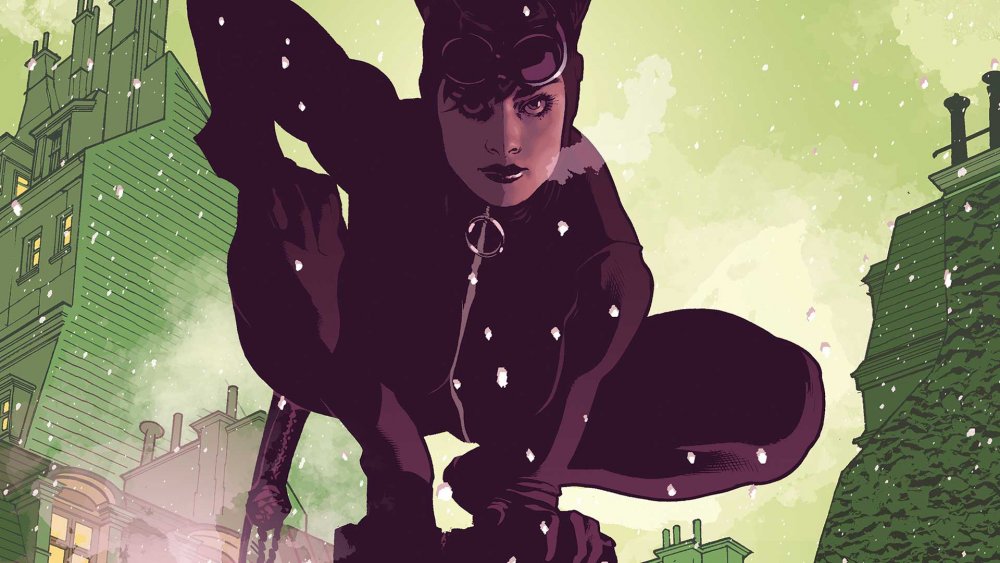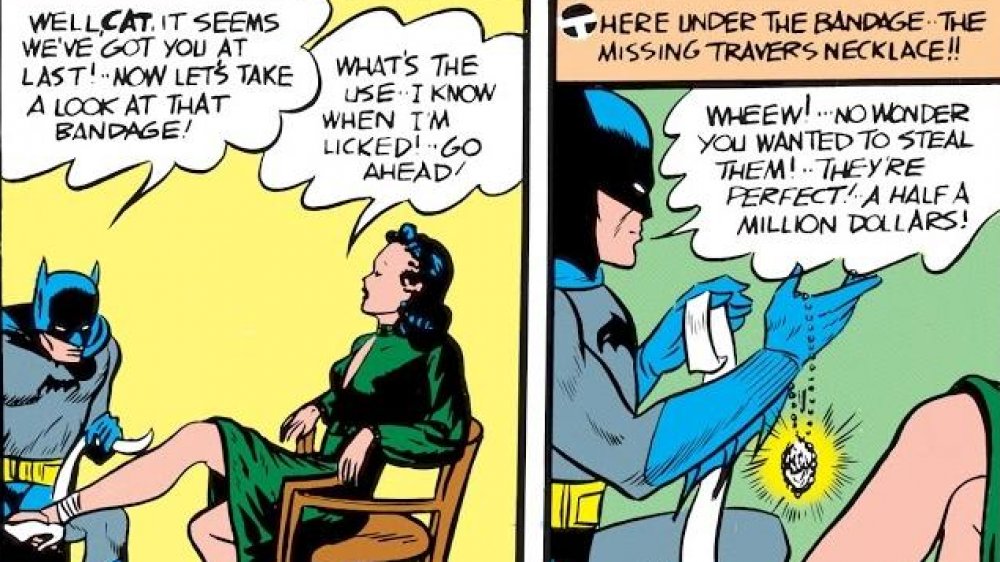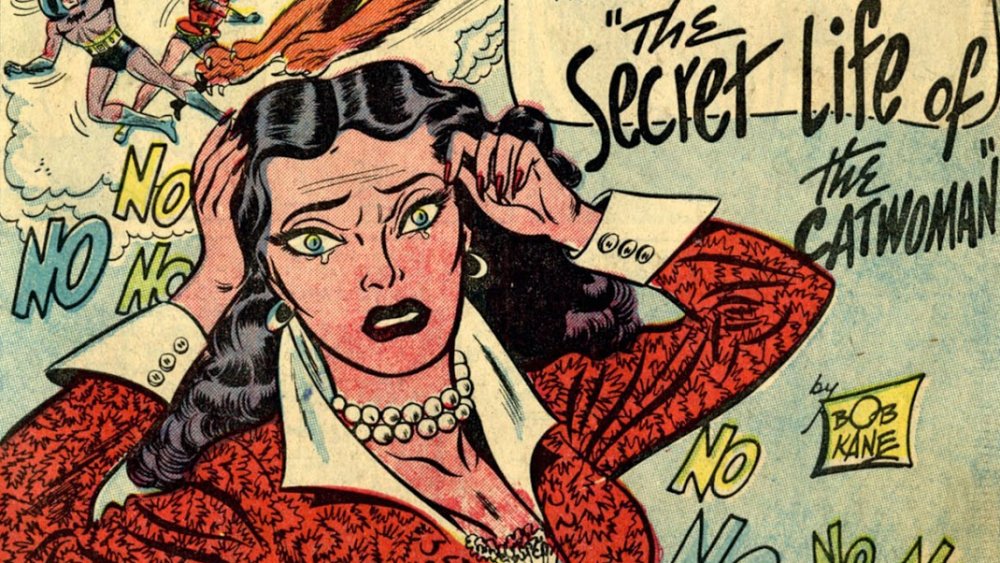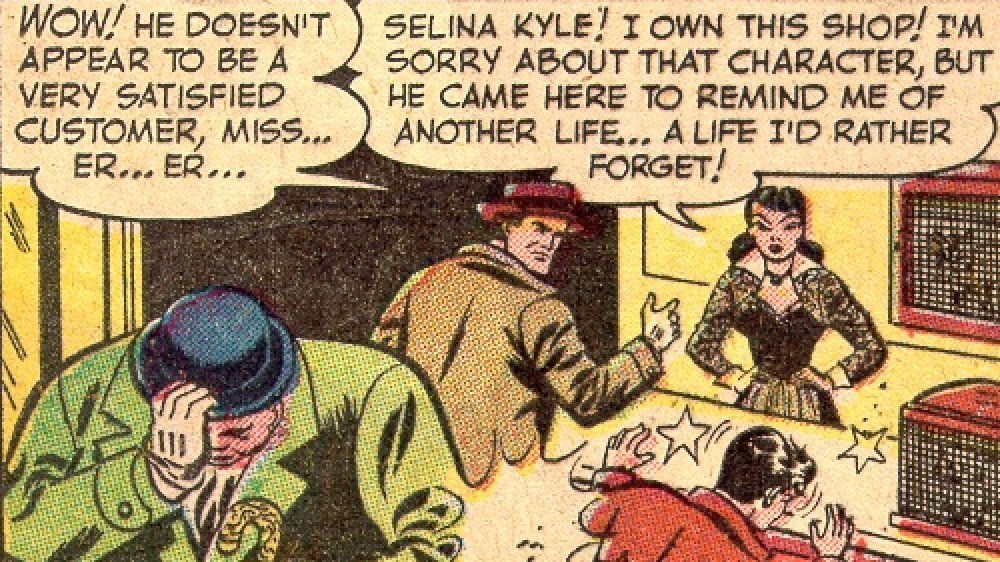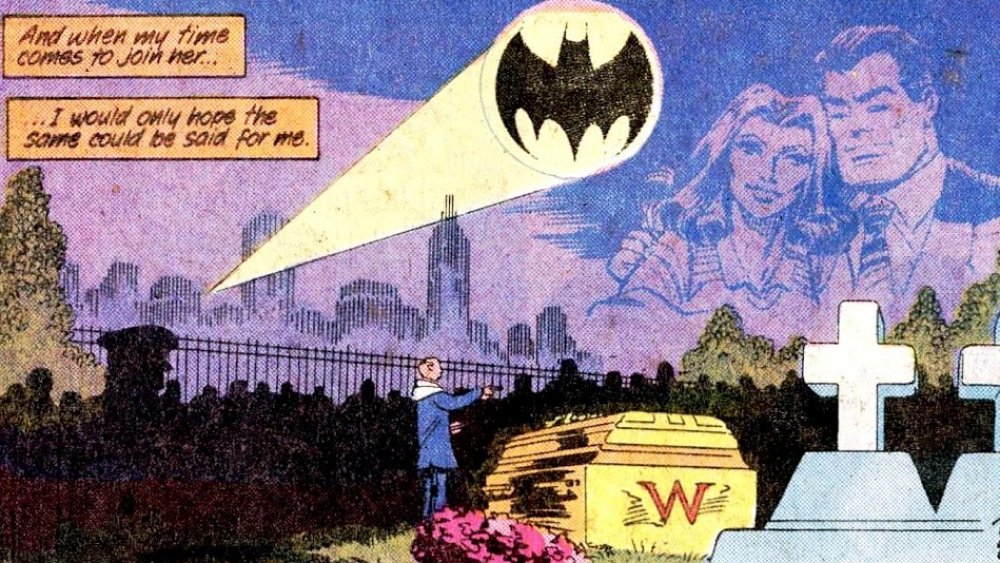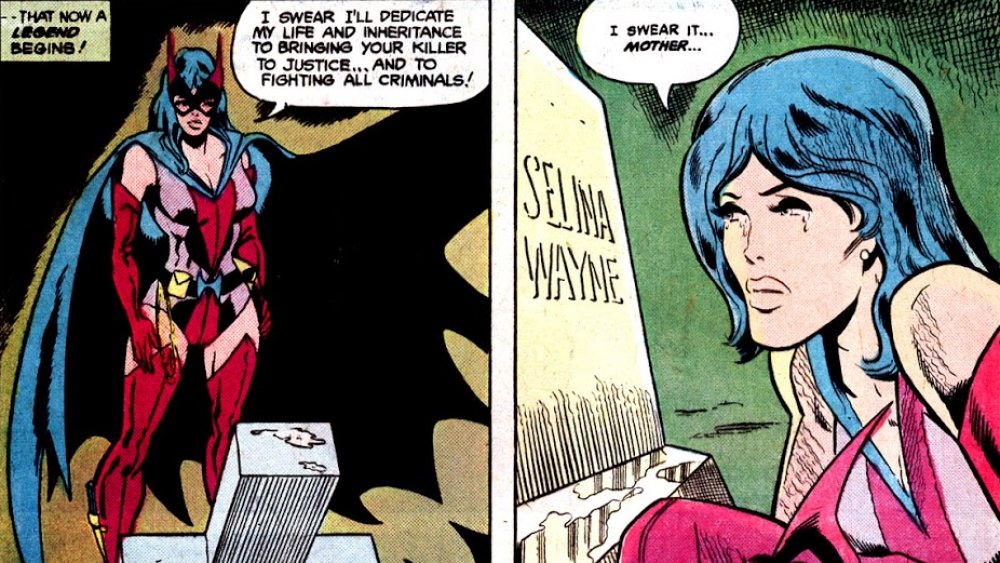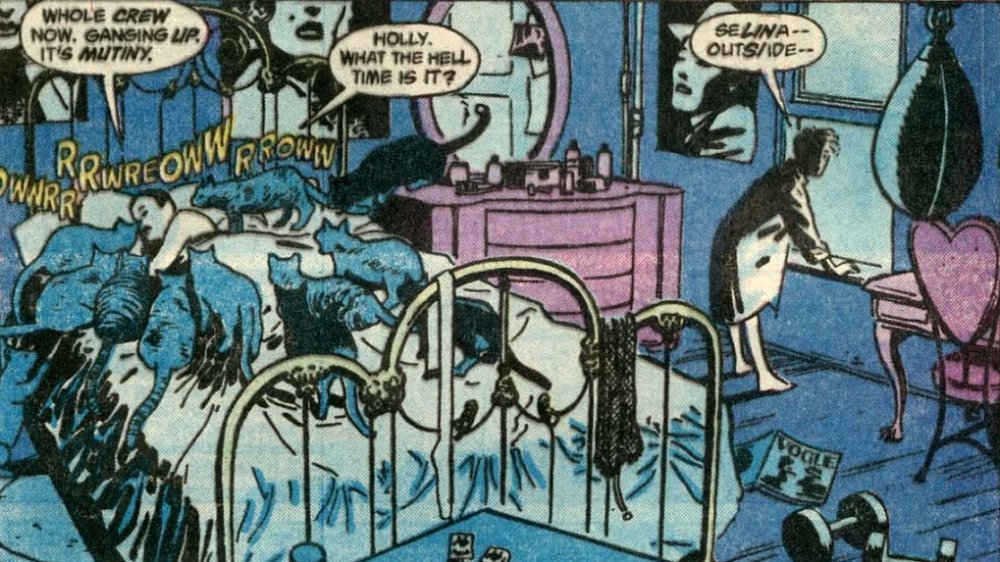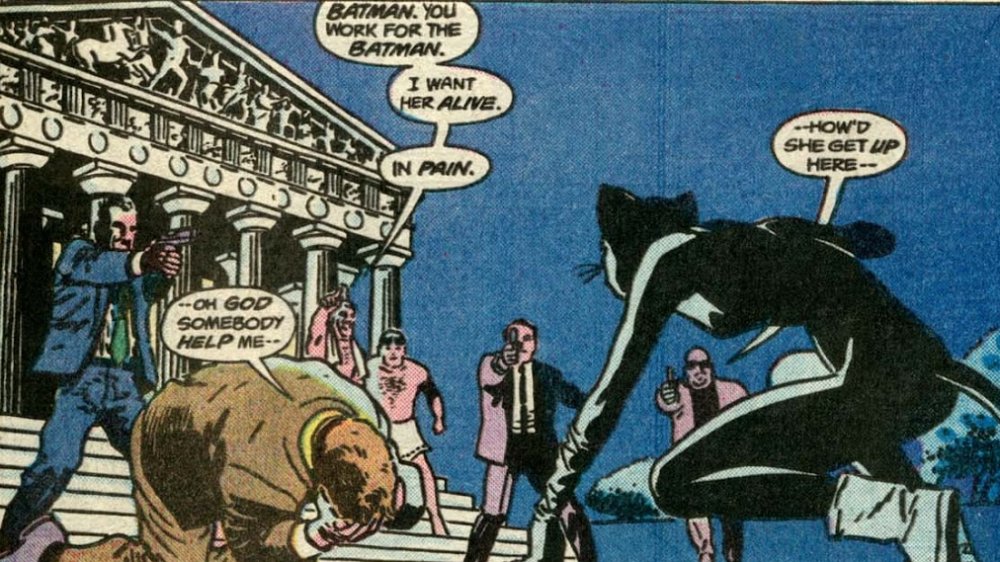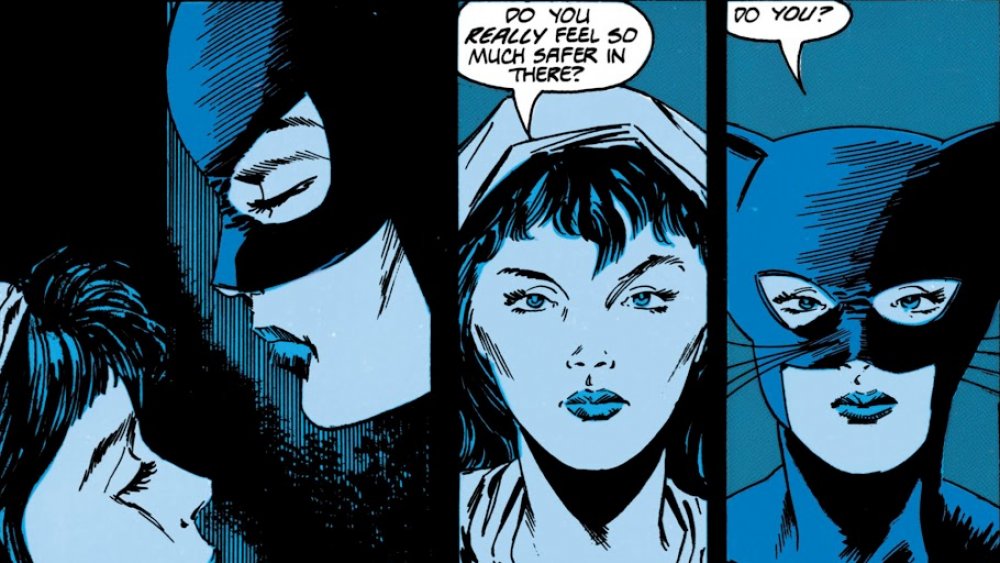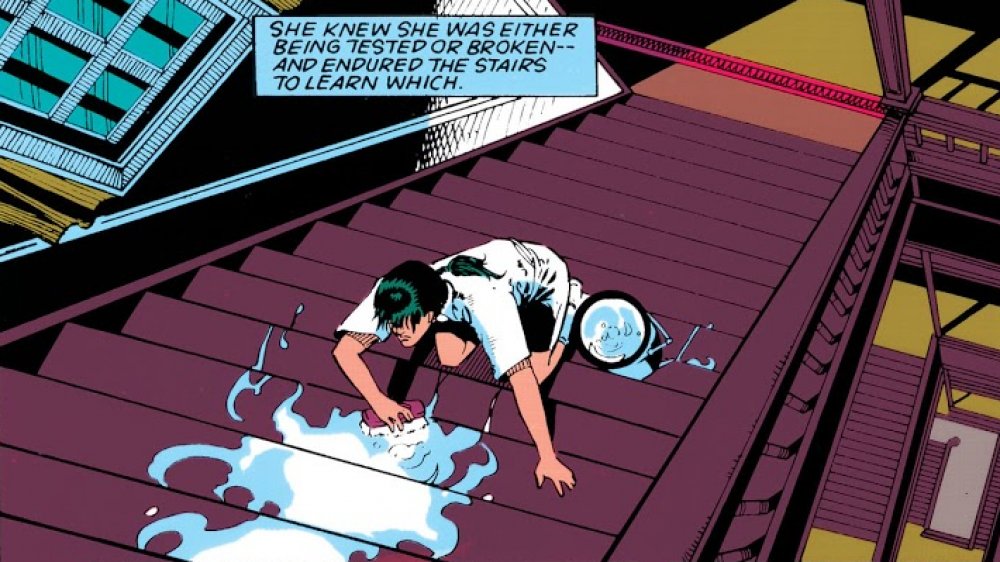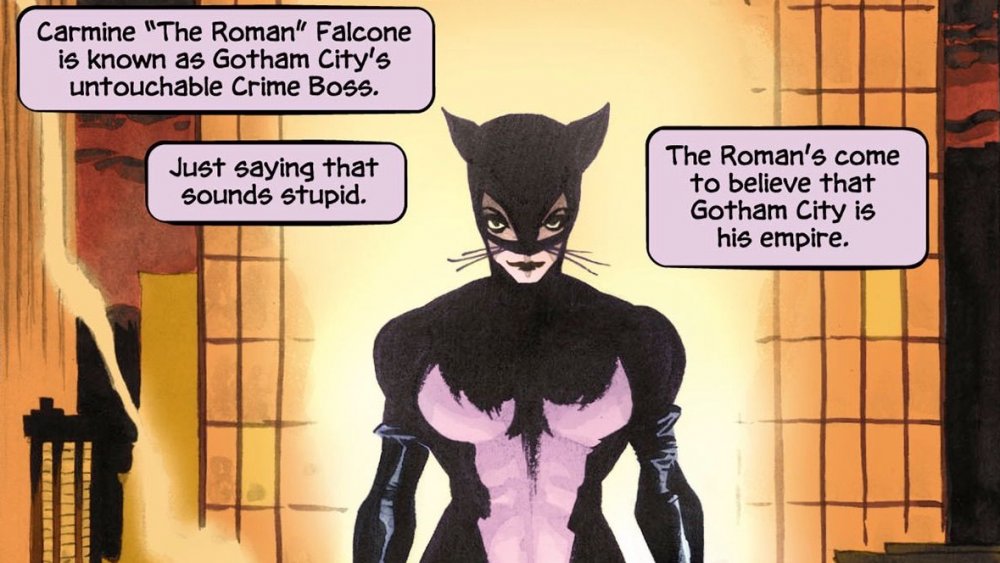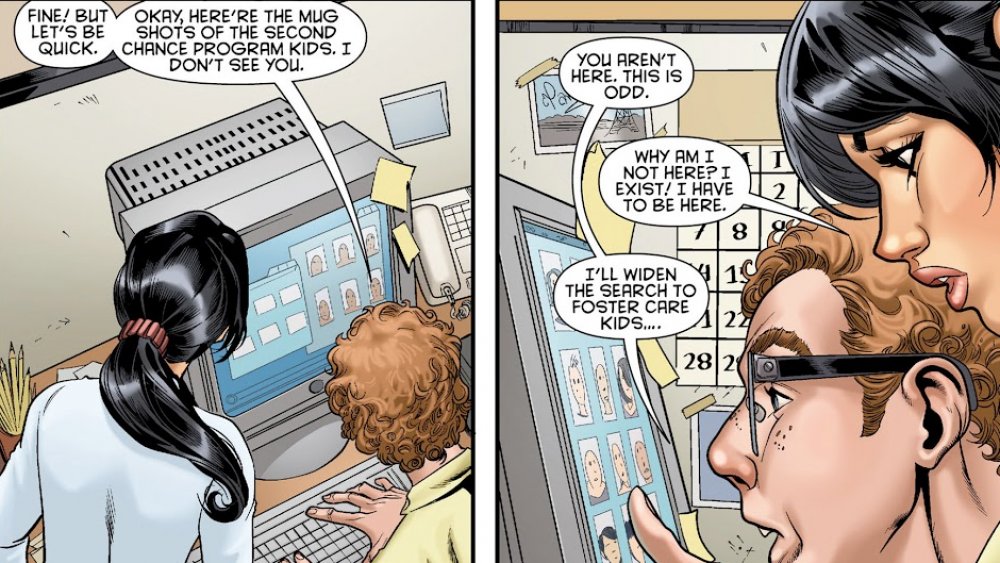Catwoman's Entire Backstory Explained
Batman has faced many adversaries over the course of his comics career. The DC universe has seen dozens of slinky villainesses arrive, cause mayhem, and depart, never to grace a comic page again. And as for antiheroes, well, head on down to your closest comic shop and take a look around you. Comics have been lousy with morally grey figures who do good things for the wrong reasons and bad things for the right reasons for decades. Heck, superhero stories even manage to be full to the brim with feline-themed bad girls. Black Cat, Cheetah, Tigress, and Catseye all fall under that surprisingly large umbrella.
Despite these commonalities, however, Catwoman stands apart as one of the most singularly memorable characters of the superhero canon. Those characters who resemble her are ever and always clearly operating from within her shadow. She's the ur-antiheroine of comics, the primordial cat burglar, and the morally ambiguous woman of the streets nonpareil. As she stole Bruce Wayne's heart (however reluctant he might be to admit it) in 1940's Batman #1, so too did she steal fans'. But how, exactly, did little Selina Kyle come to be Catwoman in the first place? Allow us to illuminate Catwoman's nine (at least) lives. This is her backstory, from the streets of Gotham to its most glittering penthouses.
The Cat and the Bat
Catwoman makes her entrance in 1940's Batman #1. Though she goes by "the Cat," she actually disguises herself as an old woman in this first appearance in an effort to make off with a fabulous emerald necklace. Batman #3 sees her live up to her name with a furred cat mask, which she pairs with flowing gowns and sky-high heels. Despite these departures from what most fans know as her signature look, she's every bit the irresistible femme fatale fans have loved for decades in these early issues — fearless, ambitious, and utterly uninterested in playing by Batman's rules. Not that he's complaining. As Robin frustratedly notes, Batman has quite the habit of letting her get away unscathed. "What a night! A night for romance, eh, Robin?" he muses, smiling to himself in Batman #3 after the lady in question has made her escape.
If there's one thing made clear by Selina Kyle's earliest appearances, it's that glamour is of the utmost importance to her. We might not know her name yet, nor the circumstances of her life, but we know she wants the biggest, brightest jewels around ... and that she understands the power of a striking get-up. Thus, Catwoman begins, as a woman utterly untroubled by the law, Batman's disapproval, and the barriers erected by Gotham's elite against people like her. She's here to have fun, cut a stylish figure, and get what she wants, by any means necessary.
Meet Catwoman, the amnesiac flight attendant
Selina receives her first origin in 1950's Batman #62. The "princess of plunder" might be in fine feline form in this issue — watching her attack Batman and Robin by unleashing a fearsomely irritated Persian cat is especially entertaining — but her own feelings waylay her when she leaps in front of a crumbling building to save Batman's life. Disoriented by the blows of the falling bricks, she claims to be a stewardess. Thus, her backstory is illuminated. Once upon a time, Selina Kyle was a mild-mannered flight attendant. A terrible plane crash spared her life, but it left her in an amnesiac haze. All she had left of her old life were her memories of her father's pet store, and so she christened herself Catwoman, in tribute to the animals her dad taught her to love. The bricks' bonk to her head have restored her memories, and now, all she wants to do is repent.
It's sentimental stuff, and it's supposed to be. At last, she's a delicate lady Bruce Wayne might actually be able to pursue. This Selina is all tears and shyness after her memories flood back, insisting she hates the thought of stealing and cannot bear the sins Catwoman (very much portrayed as a separate personality) has lain across her slender shoulders. It's a version of the character utterly at odds with modern portrayals — and all the more fascinating for it.
Selina Kyle, upright citizen
The revelation of Selina's past as an amnesiac flight attendant leads to an interesting stint of outright goodness for her. Though much drama is wrung from Batman and Robin doubting the truth of her reform, she does indeed commit — for a while, anyway — to the straight and narrow path of righteousness. She keeps her nose clean, obeys the law, and even runs a pet shop, known for its specialty in cats. And 1951's Batman #65 sees her engage in an elaborate double-cross on behalf of Batman, in which she allows some gangsters to believe she's faking her goody two shoes act. They buy it wholeheartedly ... and end up right where Batman wants them, practically gift-wrapped by Selina. Then, 1952's Batman #69 ups the ante by revealing Selina's secret brother, Karl Kyle, who terrorizes Gotham as the Cat King. Though she seems to be in league with him at first, it turns out she just wants to nudge him towards reform.
As anyone might've guessed, this spell of law-abiding comes to an end. Not even fans of the '50s wanted a Selina Kyle who goes to bed by 9 PM. So, 1954's Detective Comics #203 sees Selina grow frustrated by the press' coverage of her past crimes and the taunts of small-time crooks who'd never have dared to razz her in her villainous prime. And so she returns to the wrong side of the law, right where she belongs.
Catwoman was a bride turned burglar
A self-contained story told from the perspective of an aged Bruce Wayne, 1982's The Brave and the Bold #187 takes Selina's flight attendant origin in a completely different direction. A brutal attack from the Scarecrow brings Selina and Bruce together after years apart, and this Selina has been repenting in prison, having not returned to villainy as she did in Detective Comics #203. Selina lets slip that she consciously chose to become Catwoman, rather than being forced into it by amnesia. Bruce, ever the detective, pushes her to tell the truth. It comes out in a great, emotional rush. She had married very young to a wealthy man who turned out to be an abusive monster. When he used his connections to ruin her life after she escaped him, she decided to strike back in the only way that mattered to him. She broke into the home they once shared and robbed him blind.
As she tells it, the thieving felt so good — especially after years of cruelty and deprivation — that she couldn't stop from making it into a full-time job. This honesty spurs Bruce into revealing his own past. From the far-off future, Bruce recounts that he and Selina married soon after this encounter, and they enjoyed a warm and wonderful marriage. It might not be the dominant canon, nor would this Selina origin endure forever, but hey, it sure is nice to see these crazy kids work it out for once.
Mrs. Selina Wayne
Prior to DC's 1985 Crisis on Infinite Earths mega-event, the DC multiverse was vast and complex. Dozens of parallel universes existed, upon which hundreds of variations of classic DC heroes lived. Earth-Two was the universe of the Golden Age, and Catwoman's life played out quite a bit differently there.
In this version of her story, she retains her escaping-an-abusive-husband origin, her brother Karl, and her pet shop. However, nothing detours her from the path of sweetness and light in this world. In fact, she follows it down the aisle and becomes Mrs. Selina Wayne. A handful of issues from the 1970s and 1980s explore this version of Selina. For example, 1981's Superman Family #211 celebrates their marriage, while 1977's All-Star Comics #69 reveals their daughter, Helena Wayne, stalks the night as the heroic Huntress.
Not everything works out well for Earth-Two Selina, however. In 1977's DC Super-Stars #17, on the stands around the same time as the All-Star Comics issue that introduces her daughter, sees her blackmailed into a scheme that ultimately leads to her death. Her daughter, like her father before her, swears to avenge her by putting on a mask and bringing criminals to justice. Huntress would go on to have a glittering career as a DC superheroine, albeit one shorn of her Earth-Two ties to the Wayne family. Today, most fans know her as Helena Bertinelli, daughter of one of Gotham's most powerful crime families.
A woman of the streets
In 1987's landmark series, Batman: Year One revises Selina's origin entirely, setting the tone for nearly every rendition of the character following its release. Here, Selina is a sex worker who specializes in domination. Her life is a wasteland of cynicism and cigarettes, save for two bright points — her beloved cats and Holly Robinson, a young girl with whom she shares a pimp. Selina tries to shelter Holly from the cruelest excesses of their life, but she can't actually do much more than keep an eye out for flagrant abuse. When a disguised Bruce Wayne passes Holly on the street, he interrupts Stan, their pimp, training the girl to emphasize her juvenile nature, which is something Selina can't do anything about, lest she incur a beating.
This Selina is significantly less glamorous than her predecessors. She sports a buzz cut, leather pants, and an utterly unsentimental attitude. Yet underneath her stony exterior, the old Catwoman lurks. She still spoils her cats, still loves those chosen few who are special to her, and still enjoys the finer things in life. Thus, Catwoman enters a new age in combat boots and a black bustier, spoiling for a fight with a world that keeps her in the gutter.
Catwoman puts on the mask
Batman: Year One charts Batman's earliest days as Gotham's Dark Knight — days that Selina Kyle, along with the rest of the seedy city, watches with eagerness. So inspired is she by his audacity that she tells Holly they're leaving their old life behind. She gets her hands on a costume, throws herself into the night, and discovers she's pretty darn good at robbing Gotham's elite blind. Not that it goes all that smoothly, at first. Her inaugural robbery leaves with her a wealth of pop memorabilia she has no idea how to fence. As she grouses to Holly, she thought she'd end up with paintings and jewels, not Micky Mouse tchotchkes. It's not a mistake she makes again.
Batman, who runs into her briefly, seems to approve of her escapades. He even helps her out of a tight spot with a gaggle of mobsters. When the press attributes her burglaries to Batman, however, she's none too pleased, and she resolves to scratch her victims as a calling card. The press, clueless, deem her Batman's assistant. This less-than-ideal start ended up becoming the springboard for a wealth of wonderful Catwoman stories rooted in Gotham's seedy East End. And 2002's Catwoman solo series, a particular highlight of her history, sees her return to its alleyways to protect the women who walk them, unprotected by Gotham's justice system.
Her sister's keeper
Various comics of the '90s and '00s sketch out a childhood for Selina in the wake of Batman: Year One's hard-bitten portrayal. Her origin coalesces around three major figures — her father, her mother, and her sister. Said sister, Maggie, is introduced as a nun in 1989's Catwoman: Her Sister's Keeper. There's acrimony between the two women, who've responded to their rough start in life in dramatically different ways, but there's also enduring love. Maggie ends up leaving the sisterhood, meeting a man she goes on to marry and getting drawn into Selina's superheroic world, time and time again ... often with tragic results. Still, Selina looks after her, even when her sister would prefer to pretend she doesn't exist.
The girls' parents, explored in the '90s Catwoman solo series, were woefully ill-equipped to raise their children. Their father was an abusive alcoholic who ruled the home with rage and violence. Their mother, depicted here as a Cuban-American immigrant, was so beaten down by life that she killed herself to escape it. Not so long after, said father drank himself to death. Details are fuzzy here, with different runs offering different takes on the specifics of Selina's parents' deaths. What holds, however, is that they both died young, and that she and Maggie were left to the mercies of the streets.
If you or anyone you know is having suicidal thoughts, please call the National Suicide Prevention Lifeline at 1-800-273-TALK (8255).
Foster card, group homes, and juvie
Selina's adolescence is a rough one. The years following her parents' deaths are depicted differently over the course of many different arcs and series, but generally speaking, they involve a whole lot of adult greed and institutional letdown. Selina is often depicted as having been deposited in a state home, from which she escapes onto the streets. This is where she does her earliest thieving, a skill she refines at great cost. In time, Selina makes her way to juvenile detention facilities, many of which are corrupt. The director of one in particular is caught in the process of embezzling funds by a teenage Selina. This director attempts to drown Selina by tying her into a sack and tossing it into a river, as people did to unwanted kittens back in the bad old days. But of course, our young Catwoman has nine lives. She survives, reveals the director's crimes, and escapes the facility for good ... with the director's diamond necklace around her own throat.
This is just one tale among many told of Selina's teen years. In others, the adults that rule her life are kindly carnies, cruel gangsters, and other thieves. All of them, however, end with her in desperate circumstances that push her into sex work, burglary, and other underworld activity.
Selina Kyle: Daughter of Carmine Falcone?
First released in 1999, Batman: Dark Victory introduces a unique wrinkle in Selina's story. It implies she might just be the illegitimate daughter of infamous Gotham crime boss Carmine Falcone. Selina follows this trail through the 2004 miniseries Catwoman: When in Rome and finds ... no solid answers, unfortunately, but a whole lot of fascinating, if circumstantial, evidence.
Here's what we do know. The Falcones had two daughters. One, Sofia, figures majorly in Dark Victory and the arc that precedes it, The Long Halloween. The second daughter is altogether more complicated. The Falcone matriarch, Louisa, denies a second daughter exists, but a hitman close to the family claims otherwise. He says the second daughter was nearly murdered as an infant (Falcone feared being seen as soft for having sired two daughters and no sons), but Louisa intervened at the last possible moment. The baby girl was sent to America, where she was put up for adoption. Is she Selina? There's no smoking gun ... nothing but a hitman's memories of a child with purple eyes and black hair. But in the world of comic books, that's certainly enough to be notable.
The New 52 finds (and loses) Catwoman's brother
DC's New 52 reboot introduces an entirely new origin story for Selina. As explored in 2012's Catwoman #0, she's here remade into an orphan with no memories of her parents whatsoever. What she does have, however, are memories of a long-lost brother, torn from her by the vagaries of the foster care system. This Selina spends her childhood tossed into various group homes, one in particular run by the dastardly Miss Oliver, who forces her charges to steal for her. Nothing, however, can keep Selina from holding tight to her memories of her sibling ... or from developing a taste for the finer things in life.
With the help of a nonprofit organization aimed at struggling street teens, Selina ends up getting a job in the mayor's office. She uses her newfound government clearance to look into her own background and discovers a mysterious Russian name where hers should be. She's thrown from a roof by someone looking to keep the truth from her, and months later, she finds her files wiped. Clearly, some explosive truth about her origins is being covered up. What is this devastating secret? We'll never know. The 2016 DC Rebirth reboot throws this origin out entirely. Today, Selina's backstory is the tried-and-true Batman: Year One version, but as any fan can tell you, that could change at any moment.
